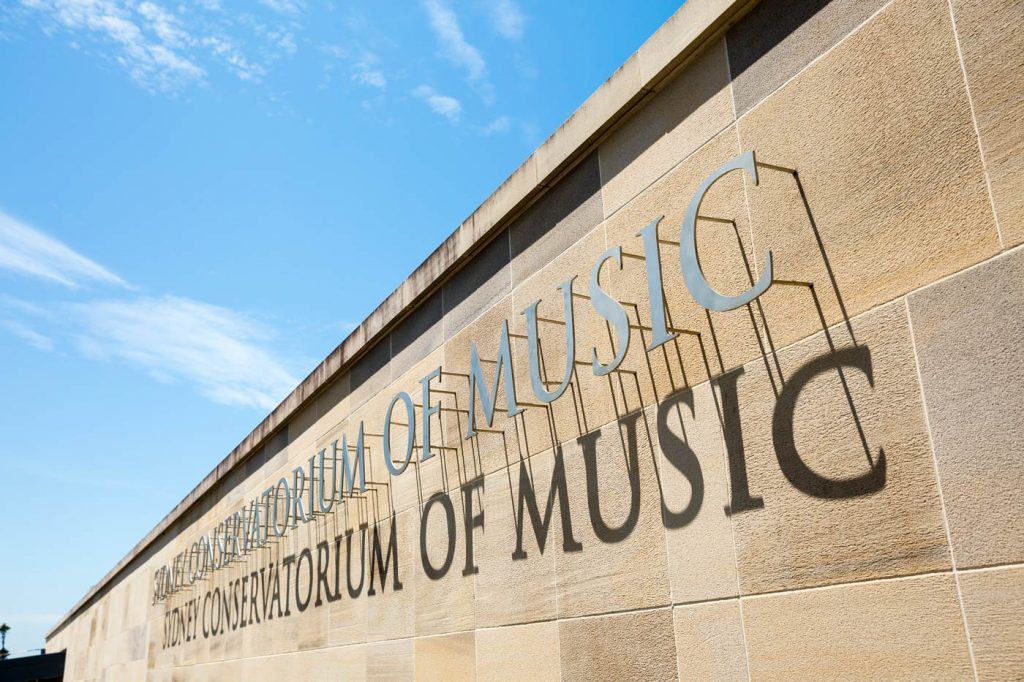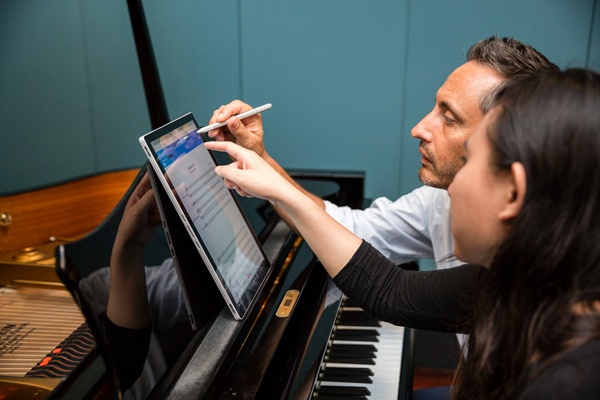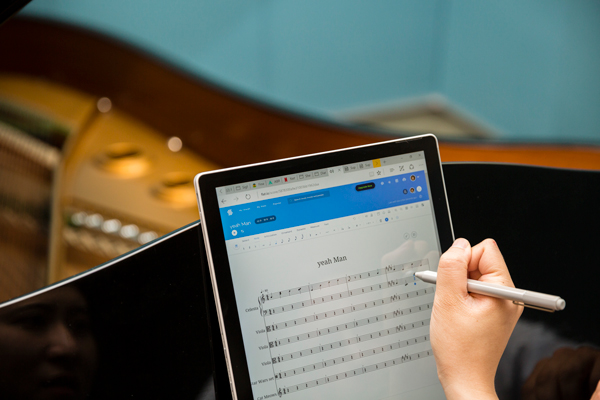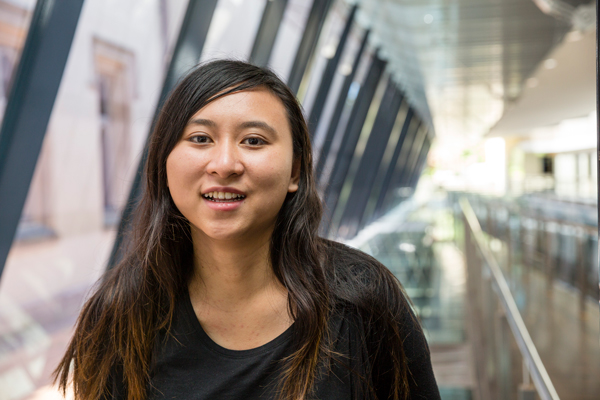
Windows 10
Microsoft and the Con mixing it up for music makers
The first instrument tertiary music student Michael Paton learnt to play was the ukulele. The second was fashioned out of a tin lunch box and his rosary beads. Today, Michael’s added a new instrument to his repertoire – Microsoft Sway.
Paton is studying a Bachelor of Music (Music Education) at the Sydney Conservatorium of Music, the University of Sydney’s music school – and using technology to engage a whole new generation of school students.
While technology will never replace good teaching and sound pedagogy, Paton says it provides a means to engage with students and lift their musical capability and awareness.
“Students see teachers as role models. If we’re stuck in the past, if we’re stuck doing arbitrary things with our technology, if we’re not moving forward then how can we expect the next generation to move forward with us?” he says.
The Con, as Sydneysiders know it, may be over 100 years old – but it’s certainly not stuck in the past.
 Dr James Humberstone, Senior Lecturer and Program Leader of the Bachelor of Music (Music Education) explains; “It’s been my feeling for a long time that you can’t really teach music education nowadays unless you’ve got a good grip on technology. The music that’s out there and around us every day is not the classical music that these guys are trained in. It’s music that is made with technology.”
Dr James Humberstone, Senior Lecturer and Program Leader of the Bachelor of Music (Music Education) explains; “It’s been my feeling for a long time that you can’t really teach music education nowadays unless you’ve got a good grip on technology. The music that’s out there and around us every day is not the classical music that these guys are trained in. It’s music that is made with technology.”
Each year the Con takes around 40 students into its long-standing, four-year Bachelor of Music (Music Education) degree – the only one of its kind in Australia. The tertiary music school has always embraced cutting-edge technology, such as purpose-built digital studios and recording suites, but they have previously been largely used by music technology students only.
Today Dr Humberstone has integrated technology more broadly at the Con and also shown how it can act as a platform for his students to teach music to school children.
“In the past we would have done very didactic teaching. We would have stood up the front and explained theory, and if students were lucky, they might’ve got to clap a little bit or play a little bit,” Dr Humberstone says. “What I try and get them to do is use technology to really form their own learning and their own knowledge – so properly constructivist education.
 “In their final year, we’ll ask them to write a unit of work where it all must be digital. That gives them a chance to look at all the skills they’ve got around technology and make something for the oldest, toughest kids they’re going to actually have to teach.”
“In their final year, we’ll ask them to write a unit of work where it all must be digital. That gives them a chance to look at all the skills they’ve got around technology and make something for the oldest, toughest kids they’re going to actually have to teach.”
Michael Paton acknowledges that teaching students in years seven and eight can be a tough gig. But he’s using Microsoft Sway to engage them, mashing up curriculum content with YouTube videos and music clips.
Paton sends his students a link to the collection of material he’s curated on Sway, and they can access that resource whenever and wherever they want. “Every time you want to look at something about Romanticism, every time you want to look at something about Balinese gamelan – it’s there. You’ve got it and I’m going to keep adding to it.
“You can take whatever you need from it, and your homework is there. The kids liked it so much that I set a task for the younger kids to make a Microsoft Sway about a style of rock music and they all used it themselves.”
Besides transforming the way teachers work in schools, technology is transforming day-to-day life at the Con. For example, students who have Office 365 accounts not only have easy access to Microsoft Office but they also enjoy a terabyte of space on OneDrive.
Dr Humberstone explains: “This means that we don’t end up with 43 different versions of the same document – especially towards the end of an 80,000 word thesis where quite often 40,000 of those words get written in the last six months. Keeping track of all the stuff and giving them lots of feedback is super-crucial.”
 While there’s a diverse range of technology at the Con, Dr Humberstone uses Microsoft Surface Pro 3 running Windows 10, which is light and flexible, but powerful enough for audio and video editing. Alongside Microsoft Office and OneNote he uses StaffPad, “which allows you to use a pen to write music onto the screen, like you would do with a manuscript.
While there’s a diverse range of technology at the Con, Dr Humberstone uses Microsoft Surface Pro 3 running Windows 10, which is light and flexible, but powerful enough for audio and video editing. Alongside Microsoft Office and OneNote he uses StaffPad, “which allows you to use a pen to write music onto the screen, like you would do with a manuscript.
“There’s another app called FL Studio which works really, really nicely in touch mode, so that if you want to work with your hands, on screen, building beats and recording stuff, you can do that.”
Dr Humberstone says he’s pleased with how his own students are also using technology in their studies and as a teaching platform.
Recent music education graduate Simon Wong has been playing piano for almost 17 years, but more recently he’s been integrating technology into lessons for his students – propping a Surface Pro on a music stand to record a student playing an instrument, to run online quizzes, and using a range of composition tools.
Like Dr Humberstone, he’s also a fan of OneNote. “OneNote is probably my lifesaver,” Wong says. “Musicians tend to like to scribble things down on the manuscript paper, like music notation, and we end up losing the manuscript. Now if I have an idea or there’s a project I need to do real quick, I just open up a new document and start scribbling on that.
“If you combine that with OneDrive that’s just perfect. I will never lose that.”
Meanwhile Master of Music (Music Education) student Rebecca Ly has made the use of technology in music education the subject of her research, looking specifically at gaming technology.
“Music education for a long time has been about discipline first before motivation – the aspect of fun comes later,” Ly says.
 To help restore fun to its rightful place, Ly has been working with the game Music Fantasia Fully Evolved, which places the player into the role of an orchestra conductor and uses the Microsoft Xbox Kinect motion sensor to determine if they are making the right gestures.
To help restore fun to its rightful place, Ly has been working with the game Music Fantasia Fully Evolved, which places the player into the role of an orchestra conductor and uses the Microsoft Xbox Kinect motion sensor to determine if they are making the right gestures.
“It gives you pointers and directions of how to move your arms,” Ly says.
She sees potential for the technology to be used in teaching people to play instruments, particularly in determining whether a student is holding their instrument correctly.
And she has also fallen in love with her Surface Pro.
“I love how you can detach the screen and use it as sheet music,” she says. “I often put a chord lyric sheet on one of my tabs, and then on another tab I’ve got a YouTube clip of somebody singing. When the student is ready to play the song, then I hit the YouTube button and we play the song in real time with the artist.
“And I love the Surface pen as well. It’s just nice to have something where I can scribble and not have to print it out.”
Dr Humberstone believes that technology will inevitably transform the way children learn about and engage with music in the classroom and beyond. But he also believes that there are broader lessons for other educators who are grappling with the challenge of motivating young students and encouraging a sustained passion for learning.
“People are looking for new philosophies and new pedagogies; new ways of teaching. Actually when you look at a lot of what they talk about doing – project-based learning, problem-based learning, broad cross curricular learning – music already does that and music is naturally technology integrated.
“I really do think that music education, when done best practice and technologically enriched, is a fantastic model for all education.”














